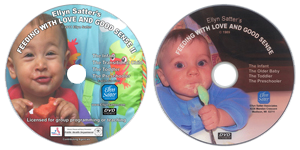
Resources and links for organizations and policy-makers
Integrate ecSatter and fdSatter into health and nutrition policyAdults and their eating
Eating competence definition and evidence
Eating competence theory and practice
Professional articles
- Satter EM. Eating Competence: definition and evidence for the Satter Eating Competence Model. J Nutr Educ Behav. 2007;39:S142-S153.
- Satter E. Hierarchy of food needs. J Nutr Educ Behav. 2007;39(Suppl):S187-188.
- Satter EM. Nutrition education with the Satter Eating Competence Model. J Nutr Educ Behav. 2007;39 (suppl):S189-S194.
- Lohse B, Satter E, Horacek T, Gebreselassie T, Oakland MJ. Measuring eating competence: psychometric properties and validity of the ecSatter Inventory. J Nutr Educ Behav. 2007;39(5 Suppl):S154-166.
- Stotts JL, Lohse B. Reliability of the ecSatter Inventory as a tool to measure eating competence. J Nutr Educ Behav. 2007;39(5 Suppl):S167-170.
- Psota TL, Lohse B, West SG. Associations between eating competence and cardiovascular disease biomarkers. J Nutr Educ Behav. 2007;39(5 Suppl):S171-178.
- Lohse B, Psota T, Estruch R, et al. Eating competence of elderly Spanish adults is associated with a healthy diet and a favorable cardiovascular disease risk profile. J Nutr. 2010;140(7):1322-1327.
- Lohse B, Bailey RL, Krall JS, Wall DE, Mitchell DC. Diet quality is related to eating competence in cross-sectional sample of low-income females surveyed in Pennsylvania. Appetite. 2012;58:645-650.
- Tilles-Tirkkonen T, Nuutinen O, Suominen S, Liukkonen J, Poutanen K, Karhunen L. Preliminary Finnish measures of eating competence suggest association with health-promoting eating patterns and related psychobehavioral factors in 10–17 year old adolescents. Nutrients.2015;7:3828-3846.
- Quick V, Shoff S, Lohse B, White A, Horacek T, Greene G. Relationships of eating competence, sleep behaviors and quality, and overweight status among college students. Eat Behav. 2015;19:15-19.
- Greene GW, White AA, Hoerr SL, et al. Impact of an online healthful eating and physical activity program for college students. Am J Health Promot.2012;27(2):e47-58.
- Clifford D, Linda A, Keeler LA, Gray K, Steingrube A, Neyman Morris M.Weight attitudes predict eating competence among college students. Family and Consumer Sciences Research Journal. 2010;39:184-193.
- Gormican A, Satter EM, Valentine J. Relationships of maternal weight gain, pre-pregnancy weight, and infant birth-weight. J Amer Diet Assoc.1980;77:662-667.
Feeding children
Feeding dynamics definition and evidence
- Satter Feeding Dynamics Model (fdSatter) definition and evidence
- Secrets of Feeding a Healthy Family Appendix I: Children and food regulation – the research
- Secrets of Feeding a Healthy Family Appendix J: Children and food acceptance – the research
Division of responsibility in feeding and in activity
Feeding dynamics theory and practice
- Cultural issues in feeding
- Primary intervention with growth
- Should you control portion sizes?
- Should you put your child on skim milk?
- Theoretical underpinnings of feeding: Research, education, intervention
- USDA FNS child feeding policies and recommendations: what is the role for the division of responsibility in feeding?
- Vegetable agenda: Getting children to eat “nutritious” food
Professional articles
- Satter E. Adjusting the Eneli et al. Feeding Dynamic Intervention to make it consistent with Satter feeding and eating models. Contemp Clin Trials. 2015;43:279-280.
- Satter E. Testing Satter’s Division of Responsibility in Feeding in the context of restrictive snack management practices. American Journal of Clincal Nutrition. 2014;100:986-987.
- Lohse B, Satter E, Arnold K. Development of a tool to assess adherence to a model of the division of responsibility in feeding young children: using response mapping to capacitate validation measures. Child Obes. 2014;10(2):153-168.
- Satter EM. Promoting “healthy” food in the context of internal regulation of eating: Comment on Slusser et al. Child Obes.2013;9:557-558.
- Satter E, Lohse B. The quest for children’s food acceptance. Journal of the Academy of Nutrition and Dietetics. 2013;113:508-509.
- Lohse B, Satter E, Arnold KS. Satter Feeding Dynamics Inventory: Response mapping identified a valid tool to assess parent adherence to the division of responsibility in feeding young children. FASEB J. 2013;27:623.627.
- Danaher C, Fredericks D. Responsive feeding and the division of responsibility. J Nutr. 2012;142(1):134.
- Estes PR, Anchondo IM. Responsive Feeding and Satter’s Feeding Dynamic Models. J. Nutr. 2011;141:2095.
- Satter E. The Satter Feeding Dynamics Model of child overweight definition, prevention and intervention. In: O’Donahue W, Moore BA, Scott B, eds. Pediatric and Adolescent Obesity Treatment: A Comprehensive Handbook. New York: Taylor and Francis; 2007:287-314.
- Davies WH, Satter E, Berlin KS, et al. Reconceptualizing feeding and feeding disorders in interpersonal context: The case for a relational disorder. J Fam Psychol. 2006;20:409-417.
- Satter EM. Children, the feeding relationship, and weight. Maryland Medicine. 2004;Summer:26-28.
- Satter EM. A moderate view on fat restriction for young children. J Amer Diet Assoc. 2000(100):32-36.
- Satter EM. Internal regulation and the evolution of normal growth as the basis for prevention of obesity in childhood. J Am Diet Assoc.1996;96:860-864.
- Satter EM. Feeding dynamics: Helping children to eat well. J Pediatr Health Car. 1995;9:178-184.
- Satter EM. The new paradigm of trust. Healthy Weight Journal.1995;9(6):110-111.
- Satter EM. The feeding relationship: problems and interventions.The Journal of pediatrics. 1990;117:S181-S189.
- Satter EM. Childhood feeding problems. Feelings and Their Medical Significance: Ross Laboratories; 1990:6-10.
- Satter EM. Should the obese child diet? In: Clark KL, Parr RB, Castelli WP, eds. Evaluation and Management of Eating Disorders. Illinois: Life Enhancement Publications; 1988:61-75.
- Satter EM. The feeding relationship. J Am Diet Assoc. 1986;86:352-356.
Adult weight and overweight
Nutrition policy and ecSatter
Child weight and overweight
Nutrition policy and fdSatter
- Child overweight: are current guidelines helpful? do they do harm?
- Prevention of child overweight in the community: Satter Feeding Dynamics Model
- Primary intervention with growth
- Satter Feeding Dynamics Model of child overweight: Evidence basis
- Should you control portion sizes?
- Should you put your child on skim milk?
- Stop being hysterical about “obesity!”
- Vegetable agenda: Getting children to eat “nutritious” food
- Your Child’s Weight: Helping without harming chapter 1 – “Help without harming”
- Your Child’s Weight: Helping without Harming Appendix I – “Health risks of child overweight”
- Weight loss for children
fdSatter theory and practice
- Children who are obsessed with food
- Children’s eating and growth
- Doctors and weight: Helping without harming
- Early infant weight gain, obesity, and adult disease
- Labeling overweight children as obese
- Overweight kids are not gluttons
- Primary intervention with growth
- Satter feeding dynamics model of child overweight
- Schools are not weight-loss camps
- Talking with your child about weight
- Stop being hysterical about “obesity!
- Toddler who “can’t get filled up”
- Your Child’s Weight: Helping without harming (Book)
Professional Articles
- Agras, W.S. et al. Improving healthy eating in families with a toddler at risk for overweight: A cluster randomized controlled trial. J Dev Behav Pediatr 33:529-534. 2012
- Eneli IU, Crum PA, Tylka TL. The Trust Model: A Different Feeding Paradigm for Managing Childhood Obesity. Obesity. 2008;16(10):2197-2204.
- Lohse B, Satter E, Arnold K. Development of a tool to assess adherence to a model of the division of responsibility in feeding young children: using response mapping to capacitate validation measures. Child Obes. 2014;10(2):153-168.
- Satter, E. Adjusting the Eneli et al. Feeding Dynamic Intervention to make it consistent with Satter feeding and eating models. Contemp Clin Trials 43: 279-80. 2015.
- Satter EM. Internal regulation and the evolution of normal growth as the basis for prevention of obesity in childhood. Journal of the American Dietetic Association. 1996;96:860-864.
- Satter EM. Promoting “healthy” food in the context of internal regulation of eating: Comment on Slusser et al. Child Obes. 2013;9:557-558.
- Satter E. The Satter Feeding Dynamics Model of child overweight definition, prevention and intervention. In: O’Donahue W, Moore BA, Scott B, eds. Pediatric and Adolescent Obesity Treatment: A Comprehensive Handbook. New York: Taylor and Francis; 2007:287-314.
- Satter, E. Testing Satter’s Division of Responsibility in Feeding in the context of restrictive snack management practices. Comment on Rollins, et al Am J Clin Nutr. 2014 100:986-987.
School and community
Nutrition policy and the Satter models
- Prevention of child overweight in the school setting: Satter Feeding Dynamics Model
- School nutrition horror stories
- Secrets of Feeding a Healthy Family Appendix H: Nutrition education in the schools
- Should you control portion sizes?
- Should you put your child on skim milk?
- Stop being hysterical about “obesity!”
- Theoretical underpinnings of feeding: Research, education, intervention
- USDA FNS child feeding policies and recommendations: what is the role for the division of responsibility in feeding?
- Your Child’s Weight Appendix G: Feeding and parenting in the school setting


